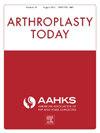头颈直径对运动弧度的影响及其在全髋关节置换术中的意义的数学评估
IF 1.5
Q3 ORTHOPEDICS
引用次数: 0
摘要
背景全髋关节置换术(THA)后的不稳定性是造成翻修的主要原因。我们的目的是评估外科医生在使用传统的大股骨和双活动度系统获得固有稳定性方面有哪些选择,以及它们之间的活动弧度(AOM)和跳跃距离(JDs)是如何变化的。Autodesk Fusion 360 是一款全尺寸计算机辅助设计软件,可以运行模拟来验证设计。它被用来计算每个模型的 AOM。结果头部尺寸从 22 毫米、28 毫米、32 毫米到 36 毫米的增加表明,每种颈部尺寸的 AOM 都有相当大的增加;但是,头部尺寸大于 36 毫米时,增加的幅度要小得多。随着颈围从 10 毫米增加到 14 毫米,AOM 有所下降。结论传统的全髋关节置换和双活动度系统都能获得比解剖正常髋关节更大的AOM。随着髋臼头直径的增加,AOM和JD也随之增加。髋臼头直径增大可改善活动范围;但髋臼头直径超过36-40毫米时,组件的稳定性几乎没有提高。现代聚乙烯内衬更耐用、更薄,因此可以使用更大的传统股骨头。在考虑传统的 THA 还是双活动度系统时,使用双活动度系统增加头部尺寸所带来的微小收益可能远远超过使用高壁内衬的大头部 THA 所带来的方向稳定性的增加。本文章由计算机程序翻译,如有差异,请以英文原文为准。
A Mathematical Evaluation of the Effects of the Head and Neck Diameter on the Arc of Motion and the Implications in Total Hip Arthroplasty
Background
Instability following total hip arthroplasty (THA) is a leading cause of revisions. Our objective was to evaluate the options that the surgeon has, to gain inherent stability with the use of conventional large femoral and dual mobility systems, and how the arc of motion (AOM) and jump distances (JDs) vary between them.
Methods
The head sizes examined spanned from 22 mm-54 mm, and neck sizes spanned from 10 mm-14 mm. Autodesk Fusion 360 is full-scale computer-aided designsoftware that can run simulations to validate a design. It was employed to calculate the AOM for each model. The JD was calculated with varying head sizes and 10- and 20-degree highwall liners.
Results
Increasing head sizes from 22, 28, 32-36 mm showed a considerable increase in the AOM for every neck size; however, there was substantially less of an increase with head sizes larger than 36 mm. As neck sizes increased from 10-14 mm, the AOM decreased. The JD increased substantially with the addition of 10- and 20-degree highwall liners.
Conclusions
Both classical THA and the dual mobility systems achieve greater AOM than an anatomical normal hip. As the head diameter increases, the AOM and the JD increases. Increases in head size improve range of motion; however, head sizes over 36-40 mm gain little regarding component stability. The more durable and thinner modern polyethylene liners allow for larger conventional femoral heads. When considering between a classical THA or a dual mobility system, the minimal gains with increasing the head size in using a dual mobility system may be far outweighed by the increase in directional stability offered by the large head THA with highwall liners.
求助全文
通过发布文献求助,成功后即可免费获取论文全文。
去求助
来源期刊

Arthroplasty Today
Medicine-Surgery
CiteScore
2.90
自引率
0.00%
发文量
258
审稿时长
40 weeks
期刊介绍:
Arthroplasty Today is a companion journal to the Journal of Arthroplasty. The journal Arthroplasty Today brings together the clinical and scientific foundations for joint replacement of the hip and knee in an open-access, online format. Arthroplasty Today solicits manuscripts of the highest quality from all areas of scientific endeavor that relate to joint replacement or the treatment of its complications, including those dealing with patient outcomes, economic and policy issues, prosthetic design, biomechanics, biomaterials, and biologic response to arthroplasty. The journal focuses on case reports. It is the purpose of Arthroplasty Today to present material to practicing orthopaedic surgeons that will keep them abreast of developments in the field, prove useful in the care of patients, and aid in understanding the scientific foundation of this subspecialty area of joint replacement. The international members of the Editorial Board provide a worldwide perspective for the journal''s area of interest. Their participation ensures that each issue of Arthroplasty Today provides the reader with timely, peer-reviewed articles of the highest quality.
 求助内容:
求助内容: 应助结果提醒方式:
应助结果提醒方式:


